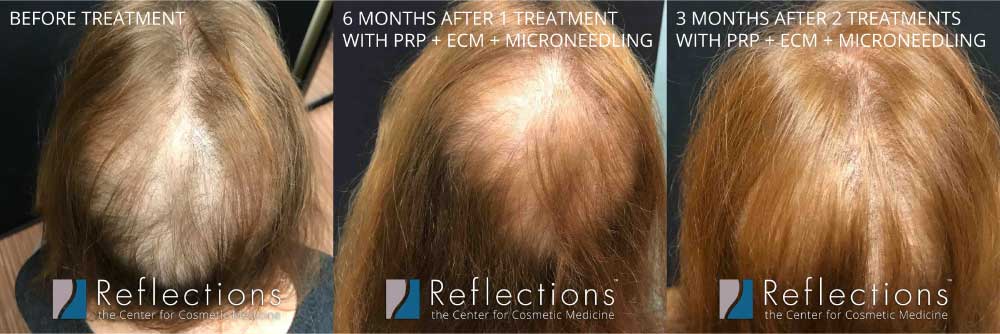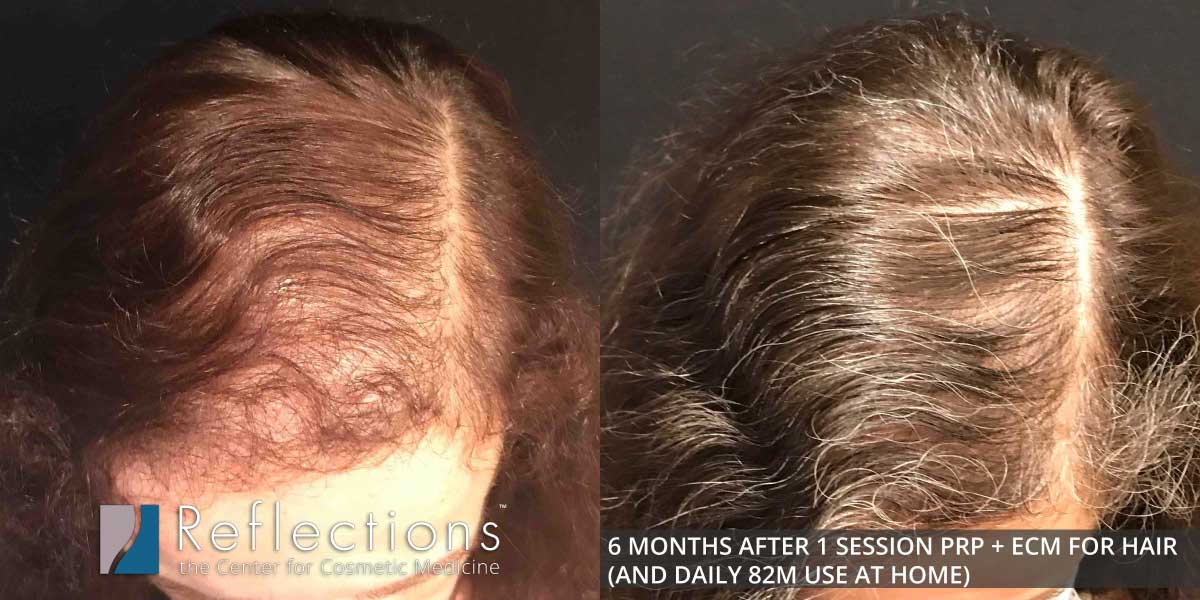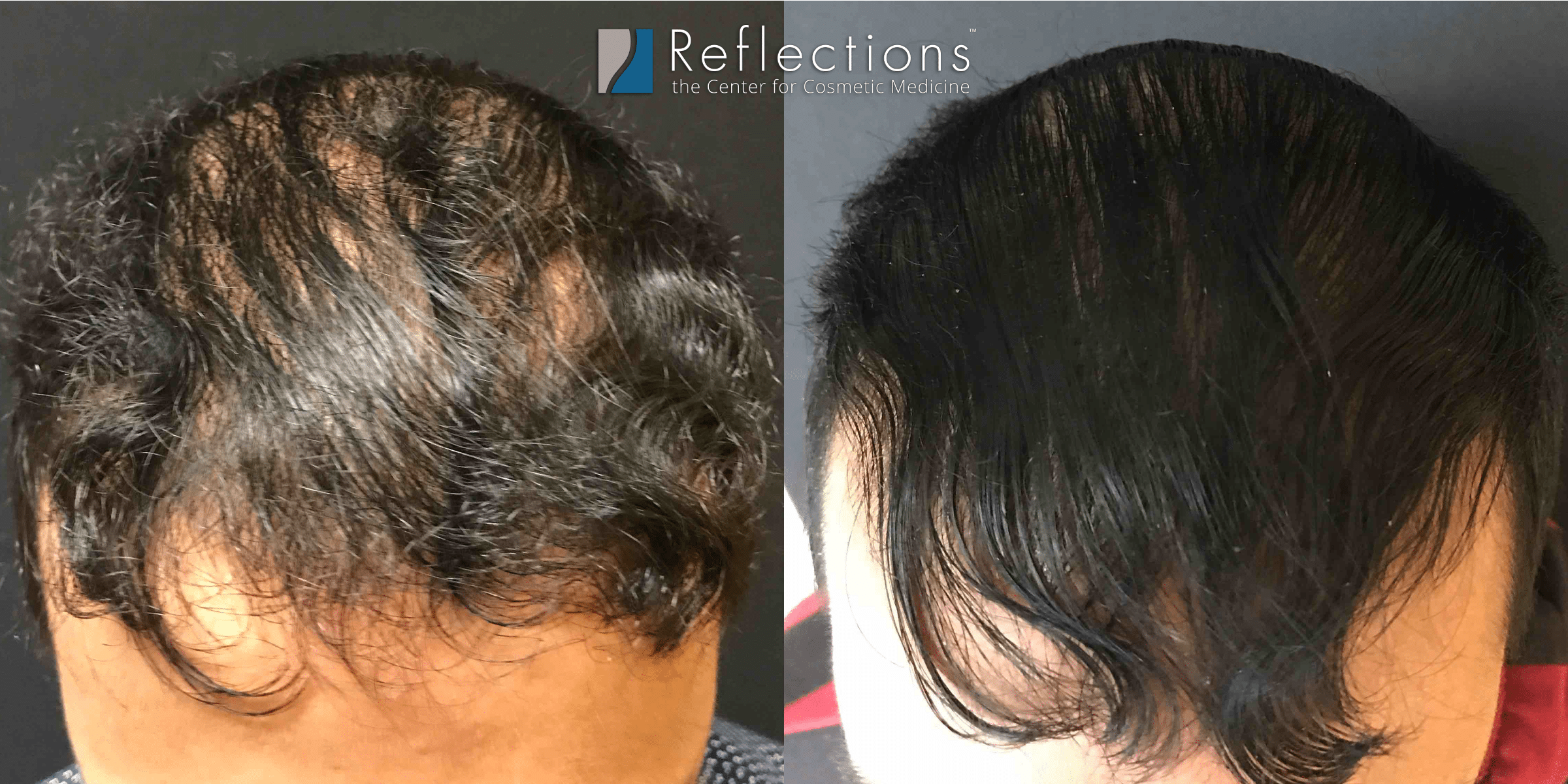Those who have experienced thinning hair, a noticeable increase in the amount of visible scalp, or other signs of hair loss, know exactly how upsetting hair loss and thinning is. If you are amongst the millions of men and women around the world who are experiencing these symptoms, Reflections Center is here for you and offers a number of great hair loss solutions. Our doctors offer the best non-surgical treatments that will help you regrow your own hair, naturally.
Top Asked Questions About Hair Loss
- Are hormones the only cause of male pattern baldness and/or female pattern hair loss?
Male and female-pattern hair loss is also called androgenic alopecia. We know the hormone androgen plays a big role in how this hair loss occurs because those men who are castrated (typically only happens in cases of testicular cancer affecting both testes - not the same as vasectomy) or who have complete androgen insensitivity syndrome will not experience this type of hair loss. But while we know it is androgen-dependent, it's not the only factor at play. We also know that high androgen levels alone won't necessarily cause hair loss. You need the perfect mix of receptors, hormones, oxidative stress, genetics, nutrition, health, and even prostaglandin changes working together to create hair loss. Because we know that there are multiple forces at play causing the hair loss, we want to attack from multiple pathways when treating androgenic alopecia. Genetic factors predispose certain men and women to hair loss and balding, but the way in which we inherit these traits isn't fully understood yet. For example, we know 80% of Caucasian men will experience male-pattern hair loss by age 70. That's much higher than the average 50% of the general population.
- How can I stop my hair loss problem?
Stopping your hair loss very much depends upon correctly diagnosing the reason it's happening in the first place, which might be a vitamin deficiency, stress, hormone changes, or a disease. We outline the causes of hair loss and our doctors can help you understand what's causing your hair loss and what treatment options you might have to stop your hair loss and to regrow your lost hair.
- Can I regrow my lost hair?
Yes, you can! Hair regrowth treatments work very effectively for areas with thinning hair, while fixing the underlying cause of hair loss and hair transplants are the only solutions that work for areas with full baldness.
What Causes Hair Loss?
We used to believe hair loss was inherited from your maternal genes, but new studies show that hair loss is caused by a combination of inherited traits (from both sides of your family), diseases (especially those that mess with your hormones), age-related hormonal changes, and environmental factors, including stress and diet.
The healthy human is born with about 100,000 hair follicles and will normally shed an average of 50 to 100 hair follicles each day1. Shedding hairs is part of the natural hair growth cycle and should not be a cause for concern. While shedding hairs is not usually the cause of hair loss, noticeable changes in your normal hair growth patterns can be a sign of hair loss.
We all naturally shed hair every single day, but as we age, the rate of new hair growth slows and the rate of hair loss can increase, causing thinning hair, balding, or receding hairlines. Understanding the reasons behind your hair loss or thinning will help you start your journey towards hair restoration and regrowth4.
Why You’re Losing Hair or Experiencing Thinning Hair
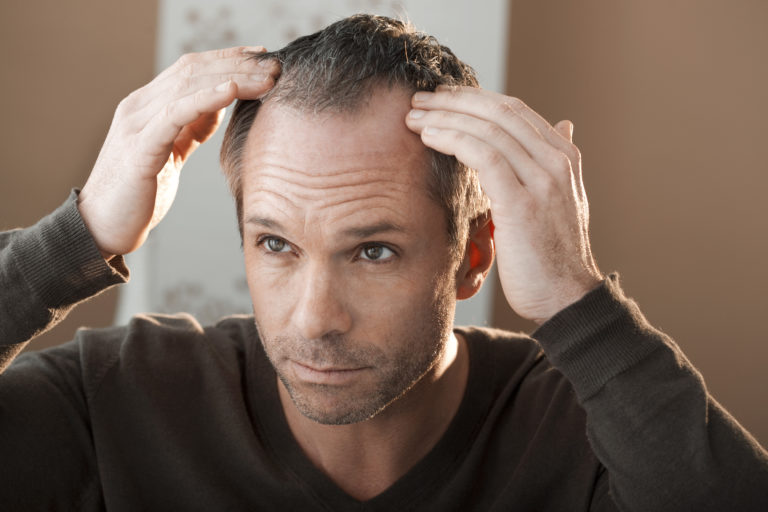
Androgenic Alopecia (Male Pattern Baldness)
This is the most common type of hair loss that people experience. It’s often referred to as male or female pattern baldness, and while you likely know the pattern for males (bald on top with full hair around the sides of the head), many people don’t realize the pattern is dramatically different for women. This means a lot of women who suffer from this type of hair loss often don’t realize this is what’s happening, especially early on when it only appears their hair is thinning along their part line.
Male pattern hair loss appears in nearly half of males over the age of fifty. With male pattern hair loss, sufferers can experience low self-esteem, body-image dissatisfaction, and general psychological distress. In men, hair loss has a close relationship with androgen and the hormone dihydrotestosterone or DHT. Men with lower amounts of DHT typically experience less hair loss. Hair loss usually spreads in an M pattern where the hairline recedes backward. Hair can also thin around the crown, creating a bald spot on top of the head. Left untreated, male pattern hair loss will nearly always progress to full baldness. Once baldness has occurred in an area, only hair transplant surgery remains a viable treatment option. This is why early intervention is the key to keeping and restoring hair for men.
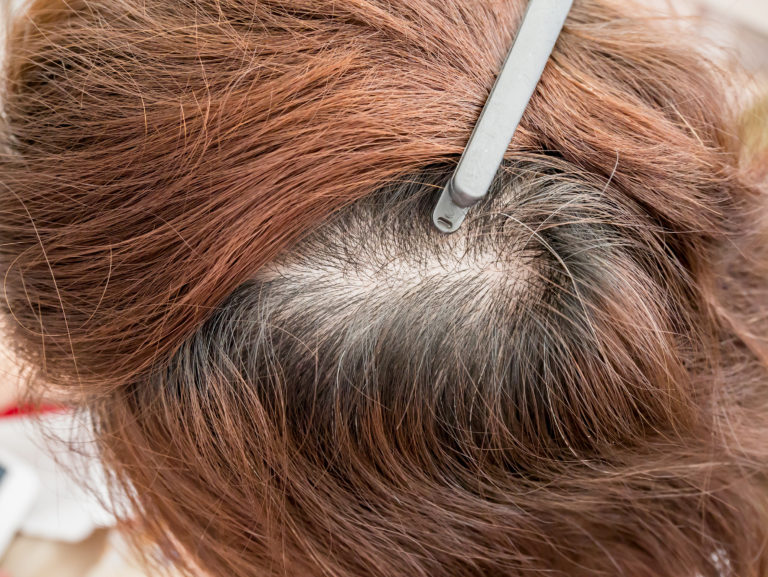
Androgenic Alopecia (Female Pattern Baldness)
Female pattern hair loss is known to affect half of women by the time they reach the age of 653. The majority of women who do suffer from hair loss will experience it after menopause. The condition is hereditary but is also closely linked to hormone levels, specifically with testosterone levels. Female pattern baldness appears in three stages. First, thinning hair develops along the natural parting of your hair. Then, the part widens exposing more and more scalp. Finally, thinning spreads to the point where hair becomes sparse enough to see through to the scalp.
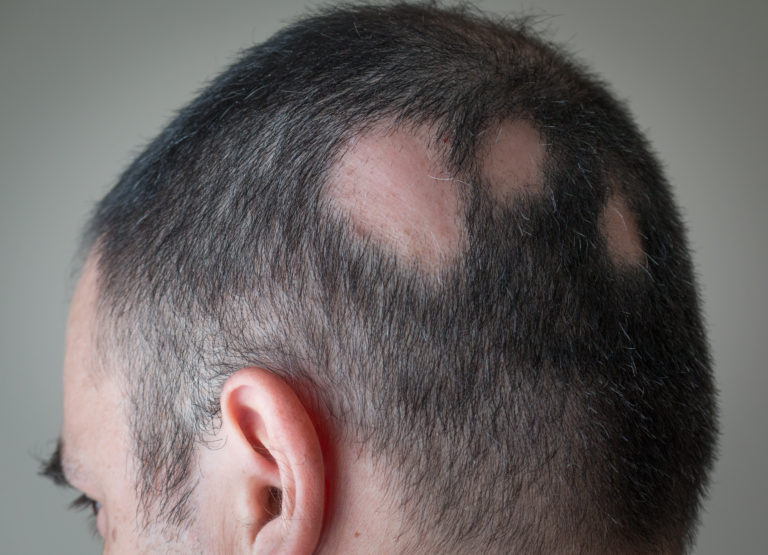
Alopecia Areata
Alopecia areata is a sudden loss of hair resulting in patchiness, which is often temporary. This is an autoimmune disease wherein the immune system attacks the hair follicle. The good news is the follicles remain intact, which means this type of hair loss can be reversible as the underlying condition is treated. It occurs when the signal that usually happens during the telogen phase of hair growth seemingly occurs earlier and for a high number of hairs in a given area. This causes the body to shed hairs from follicle, bulb and all.
This condition can be seen in adults as well as young children. Usually, full regrowth of hair is expected.
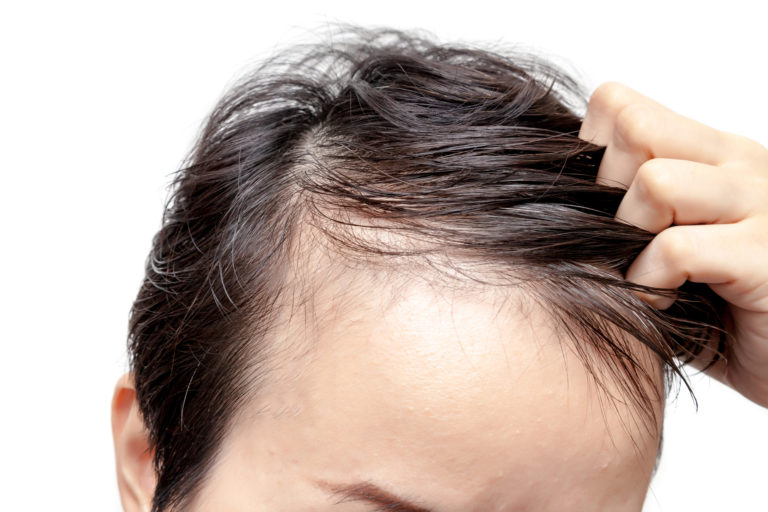
Alopecia Universalis
This condition causes hair loss all over the body, including eyebrows and eyelashes, and is very rare.
Trichotillomania
Trichotillomania is a condition that mostly occurs in children in which they pull out their own hair. This is typically an attempt to self-soothe through a period of extreme stress or even PTSD.
Telogen Effluvium
This fairly common condition is characterized by cyclical diffuse (all-over) thinning of hair on the scalp. It’s a temporary hair thinning as a result of a change in the follicle growth cycle, usually caused by stress or disease. When someone has fallen ill and their hair thins, this is usually the cause. It will typically reverse itself once the patient is healthy again.
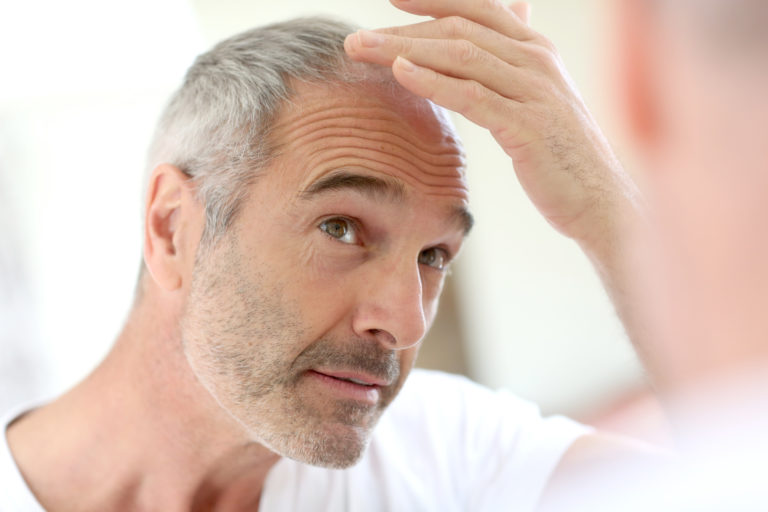
Scarring Alopecias
Scarring alopecias were long thought to damage the hair follicles in a way that was not treatable. But some patients have had success with MicroFat injections, which work by isolating and concentrating your own ADSC for reinjection into the scalp. MicroFat has been used in many applications including poorly healed wounds, so it stands to reason that it may be a good option for these previously untreatable conditions. Scarring alopecias are often the effect of diseases, such as lupus, erythematosus, etc., and properly treating and controlling the underlying disease is an important key to any successful long-term result.
Infections: Ringworm and Folliculitis
Ringworm and folliculitis are two of the most common infections which can cause hair loss. Usually, this hair loss is temporary and resolves once the infection is treated.
The Best Treatments For Hair Loss
There are certain treatments that work best for each cause of hair loss, and there are some treatments that won’t work at all for certain types of hair loss.
Hair Growth Stimulating Injections
Stimulating the body to regrow its own hair with injections has been widely accepted as the best choice of treatment for thinning hair for many years now. However, the science is developing quickly in this area, and what we’re injecting, as well as the protocol for how many treatments to do, how far apart, has changed over this time.
PRP injections for hair restoration have been popular for the past few years, but in this video we’re exploring what new science (and proven treatments) have changed this style of hair restoration and will continue to shape this category in 2020.
- We generally don’t recommend Concentrated Platelet Injections alone anymore – we tend to recommend either adding Collagen-Based Cellular Scaffolding (CBCS) and/or Concentrated Micro-Fat Injections . Most patients choose CBCS because it doesn’t require them to donate fat, but either of these additives makes the results from Concentrated Platelet Injections so much stronger that we feel it is worth the investment because you’ll need fewer and/or less frequent Concentrated Platelet treatments.
- We almost always adjunct any injection treatment with microneedling, which spurs further repair and reactivity in the scalp.
- We always create a home maintenance plan: this could include topical medicines or pills, supplements, shampoos, and/or low-level lasers. The important thing is to treat any underlying medical conditions or nutritional deficiencies that are preventing hair growth or causing hair loss, and then to create a plan that the patient can stick with in the long term. Consistency matters here.
Vitamins, Supplements, & Laser Cap
For some patients, healthy hair is limited due to a vitamin or mineral deficiency. In this case, we recommend just a couple of very high quality supplements, which we do sell in our office. Nutrafol is one of our favorites.
For others, inflammation in the scalp is a part of the problem, in which case (depending upon the cause of that inflammation), we may recommend Laser Cap, Ketoconazole Shampoo, Kenalog Steroid Injections, or other at-home treatments to keep inflammation down and allow the new hair to be healthy and thrive.
Prescription Medications
Most people who suffer from hair loss have an underlying medical condition at play. For the vast majority of patients, that’s male or female pattern baldness, which is related to hormonal imbalances in the scalp. There are certain treatments that work best for each cause of hair loss, and there are some treatments that won’t work at all for certain types of hair loss.
Here are some examples:
- Topical steroids, minoxidil (Rogaine), cyclosporine, oral steroids, or photodynamic therapy offer no results for those with alopecia areata, even when used over a long period of time6.
- Minoxidil work amazingly well for hair regrowth in female pattern hair loss (even though it was originally marketed as Rogaine for Men!)7
- Where Propecia (Finasteride) works very well for male pattern baldness8,9, Finasteride is ineffective in postmenopausal women with female pattern hair loss10.
When the baldness is caused by female or male pattern baldness that has been allowed to advance to the stage where there are areas with no hair remaining, it is very difficult to cause the hair in that area regrow. In those cases, hair transplant surgery is likely your only option.
Hair Transplant Surgery
We Do Not Offer This Treatment
Hair transplant surgery removes a section of healthy hair from the scalp, sections out the individual hairs, and then re-implants those hairs in the areas of baldness throughout the scalp.
There is considerable downtime and the scar, while typically well-hidden in the hair, can be significant.
Typically, not all of the hair that is transplanted survives, and those that do survive will shed before growing back in – so this adds to the length of “social downtime” as covering this with a hat appears to decrease the survival rate for hair.
However, in those willing to go to this extreme, we do see good results in many patients, especially when the surgeon uses more advanced robotics to help increase quality of hair transplant follicles, such as F.U.E.
Prescription Medications to Treat Underlying Medical Conditions
For some patients, the cause of baldness is a disease or condition of the skin in that area. In that case, prescription medications and shampoos can provide a good treatment option that creates lasting results.
Typically, for these patients, the hair is lost as a thinning out process. The earlier in this process that you diagnose the skin condition and begin treatment, the better your chances of not having permanent scarring damage done to those hair follicles.
It is also a potential option to first treat the condition, and once that’s under control, use hair growth injections and stimulating treatments to increase the density and thickness of that hair. But it would be futile to do so before the causal condition is first well-managed.

View More Hair Restoration Before & Afters
More Before & Afters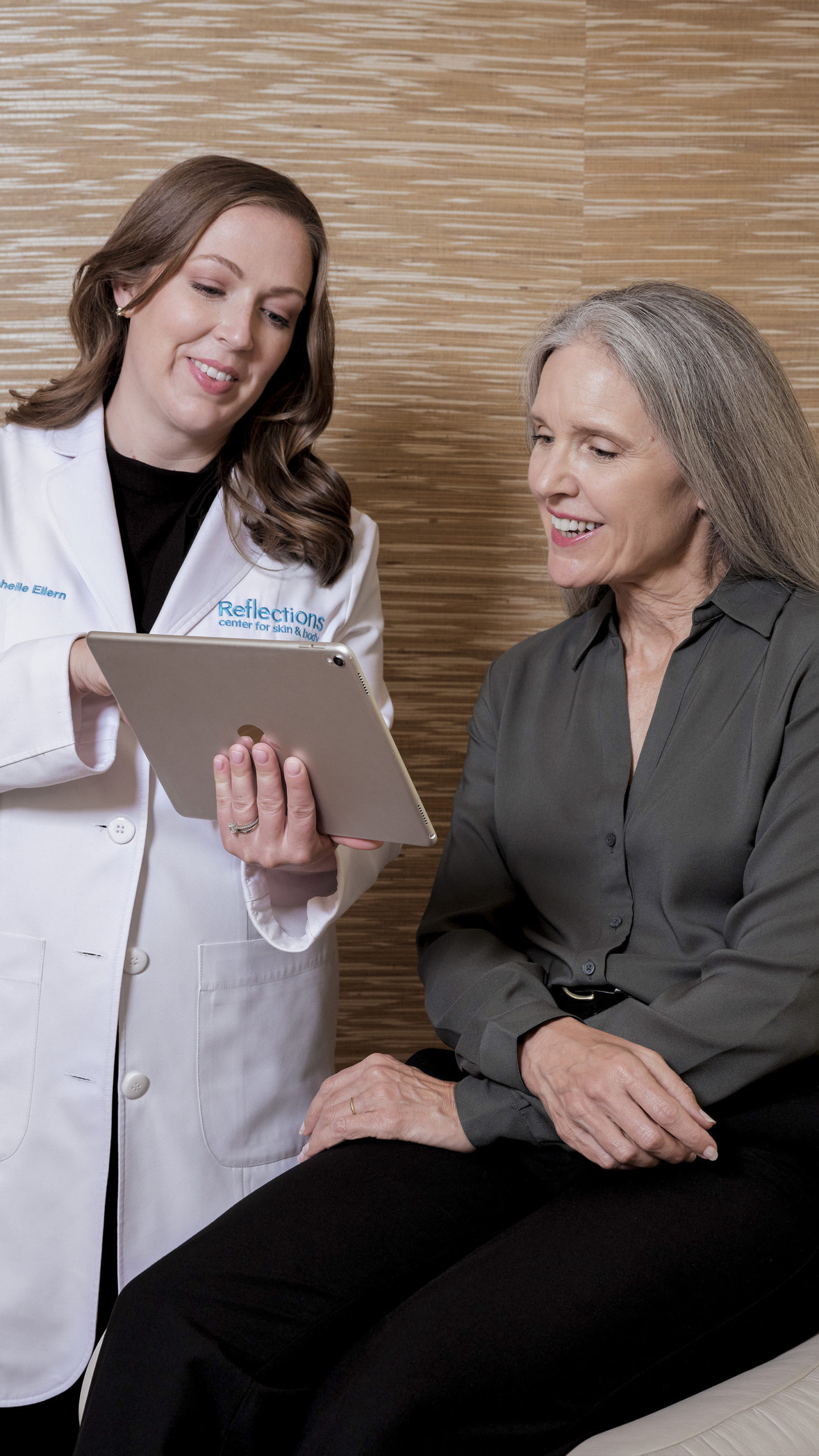

Why Choose Reflections for Hair Loss?
We understand that hair loss can take a negative toll on your self-esteem, which is why we offer only proven treatment options for the best possible results.
At Reflections Center, we pride ourselves on our commitment to offering the most advanced, scientifically-backed treatments. We are proud to offer proven hair loss treatments that give patients great results that are natural (because they are your own hair growth) and long-lasting. We believe in creating individual treatment plans that take into account a patient’s budget, lifestyle (ability for downtime and at-home maintenance), and goals for a customized aesthetic outcome.
At our office, you’ll always meet with a doctor who will work to help create the right environment in your body for naturally full and healthy hair, which is very different than how most medspas and hair transplant surgeons work these days. We’re not interested in a great result that are going to slowly fade over the next few years. We want your head to be healthy so it can have hair that is thriving for decades to come!
A free consultation with our cosmetic physicians is the first step in restoring your hair and confidence! Contact us today to schedule your consultation!
Our Approach Allows You to Regrow Your Own Hair Naturally

In the United States, roughly half of all men (and women, too) will start showing signs of baldness by their 40th birthday, according to one study performed by the Cleveland Clinic. Our physicians know the market is full of pseudo-science when it comes to hair growth remedies, and we’re here to set the record straight about what the science actually says – and the good news is, the science says that for the vast majority of patients, we can regrow their hair and dramatically decrease, or even stop, hair loss.
We are proud to be members of the American Society of Hair Restoration Surgery, a group of physicians dedicated to scientific research and development of cutting-edge treatments that change the lives of our patients.
The Hair Growth Cycle
Hair grows in three phases: anagen, catagen, and telogen. Each hair on your head alternates between each phase in a regular cycle throughout its entire life. The initial phase is anagen when the hair follicle is growing from the bulb of the hair follicle and may last as long as eight years. The next phase is the catagen phase, a stagnant transitional phase. Then during the final telogen phase, the hair follicle receives a signal from the body to detach from the scalp. At this point, the hair and bulb detach from the follicle and fall out. The source and cause of the signal are not entirely understood. After each phase is complete, a healthy, active hair follicle will start its hair growth cycle over.
Hair growth cycles are affected by a variety or a combination of factors that lead to hair loss. The exact cause of hair loss has remained elusive, but a combination of factors such as hormones, stress, and your genes are known to play a role.
As much as 50% of adult men and women may experience some form of hair loss in their lives2. Generalized hair loss is when more and more hairs stagnate in the resting phase, telogen. When these hairs are lost, they do not re-enter the anagen phase, leaving these areas of the scalp bald. Generalized hair loss, in many cases, is telogen effluvium. Telogen effluvium can be triggered suddenly by stress, thyroid disorders, menopause, and age. Iron deficiencies are also known to have links to telogen effluvium.
Telogen effluvium, an increased pattern of thinning hair, may be diagnosed with a hair pull test. This test is performed by grabbing about 40 to 60 hairs and pulling along the length of the hair to see if there is an excessive amount of hairs lost. More than 10% is an indication of hair loss.
Frequently Asked Questions About Hair Loss & Balding
- Are hormones the only cause of male pattern baldness and/or female pattern hair loss?
Male and female-pattern hair loss is also called androgenic alopecia. We know the hormone androgen plays a big role in how this hair loss occurs. But while we know it is androgen-dependent, we also know that high androgen levels alone won’t necessarily cause hair loss. You need the perfect mix of receptors, hormones, oxidative stress, genetics, nutrition, health, and even prostaglandin changes working together to create hair loss.
Because we know that there are multiple forces at play causing the hair loss, we want to attack from multiple pathways when treating androgenic alopecea, or female and male-pattern hair loss.
Genetic factors predispose certain men and women to hair loss and balding, but the way in which we inherit these traits isn’t fully understood yet. For example, we know 80% of Caucasian men will experience male-pattern hair loss by age 70.
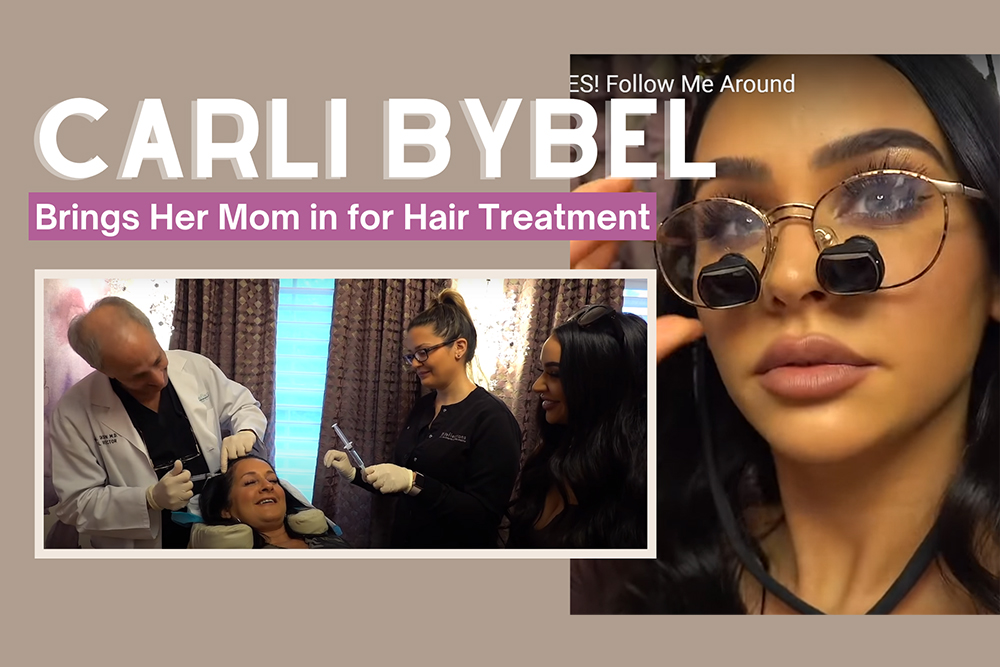
Blog
Carli Bybel Brings Her Mom to Our Office for Hair Injections
By now, you all know how we feel about Concentrated Platelet injections for...
Read More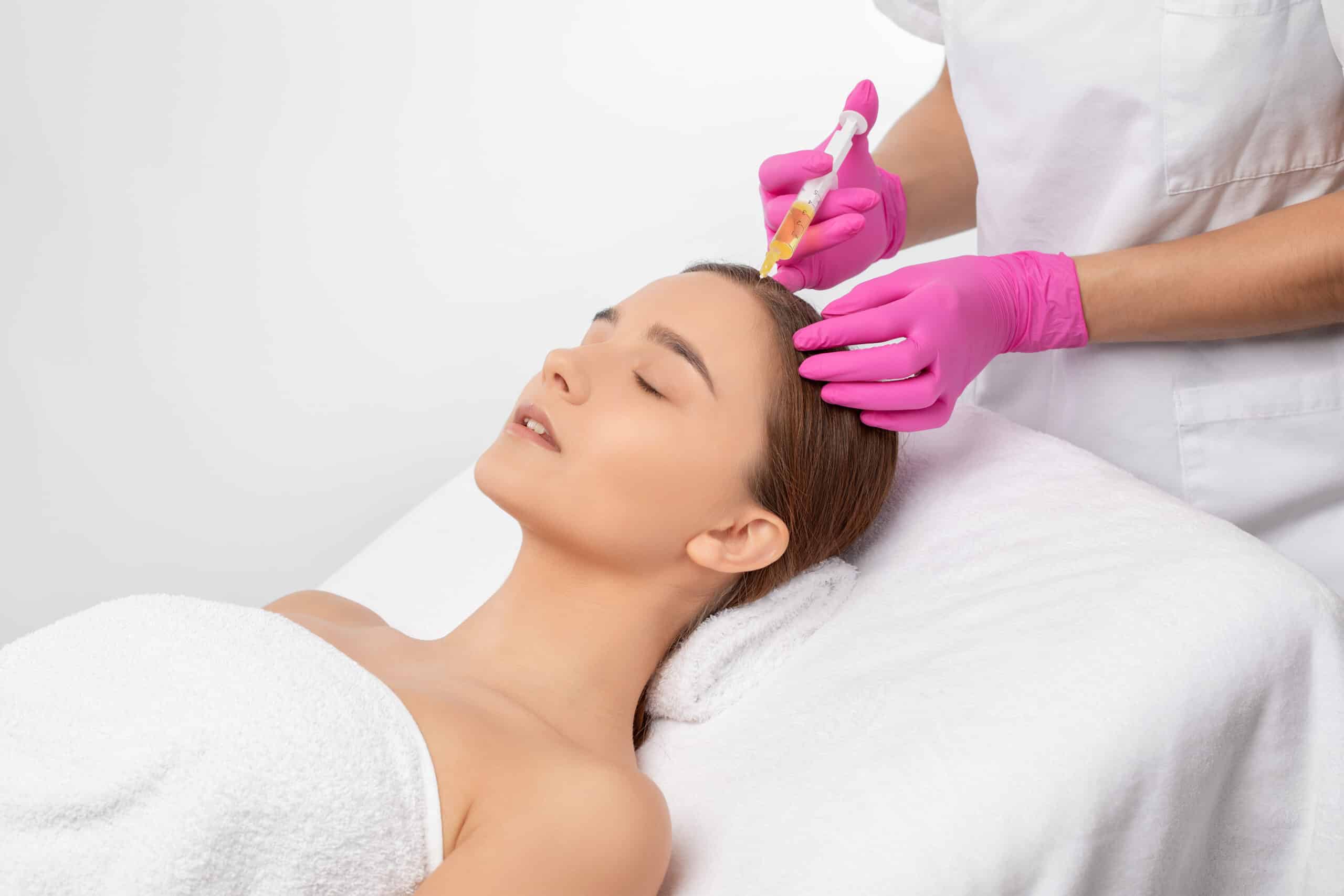
Blog
Private: Injections for Hair Loss: What’s Changed? Updates with Dr. Chasin
Over the last 5 or so years, injections for hair loss have become the go-to...
Read More
Blog
15 Most Popular Treatments for Men
For many years men sat idle, wishing they could do things to improve their...
Read MoreSchedule Your Free Consultation
With One Of Our Physicians
Schedule Now
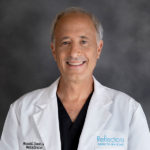
Dr. Mitchell Chasin is a Cosmetic & Laser Physician at Reflections Center. Dr. Chasin believes strongly that the best cosmetic physicians are those who are dedicated to mastering their craft through continuing education and collaboration with the industry’s top doctors.




